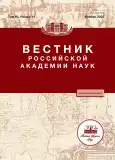THE MILITARY-ORIENTED R&D ORGANIZATION AND MANAGMENT SYSTEM IN THE UNITED STATES
- Authors: Pankova L.V.1, Gusarova O.V.1, Stefanovich D.V.1
-
Affiliations:
- Primakov National Research Institute of World Economy and International Relations, Russian Academy of Sciences
- Issue: Vol 93, No 11 (2023)
- Pages: 1081-1094
- Section: ЗА РУБЕЖОМ
- URL: https://journal-vniispk.ru/0869-5873/article/view/233564
- DOI: https://doi.org/10.31857/S0869587323110087
- EDN: https://elibrary.ru/CNMBOT
- ID: 233564
Cite item
Full Text
Abstract
The article is devoted to the issues of defense R&D management in the USA as one of the global leaders in innovation and digital development. The authors aim to deepen the understanding of the organizational and managerial component of the defense R&D domain both conceptually and in terms of its general structure, planning and regulation under the dynamic scientific and technological transformations. The authors note the active tendency to improve the model of interaction between government organizations and business and highlight the most significant innovative organizational and management initiatives in the defense R&D domain, as well as the main factors and tools of their implementation.
About the authors
L. V. Pankova
Primakov National Research Institute of World Economy and International Relations, Russian Academy of Sciences
Email: lpankova@imemo.ru
Russia,
Moscow
O. V. Gusarova
Primakov National Research Institute of World Economy and International Relations, Russian Academy of Sciences
Email: olgusarova@imemo.ru
Russia,
Moscow
D. V. Stefanovich
Primakov National Research Institute of World Economy and International Relations, Russian Academy of Sciences
Author for correspondence.
Email: stefanovich@imemo.ru
Russia,
Moscow
References
- Department of Defense Research, Development, Test, and Evaluation (RDT&E): Appropriations Structure // Congressional Research Services. 2020. Oct. 7. https://fas.org/sqp/crs/natsec/R44711.pdf
- Department of Defense Releases the President’s Fiscal Year 2024 Defense Budget // US Department of Defense. 2023. March. 13. https://www.defense.gov/ News/Releases/Release/Article/3326875/department-of-defense-releases-the-presidents-fiscal-year-2024-defense-budget/
- DOD Seeks Increased Microelectronics Funding for FY 2024 // US Department of Defense. 2023. April 18. https://www.defense.gov/News/News-Stories/Article/Article/3367040/dod-seeks-increased-microelectronics-funding-for-fy-2024/
- Perez L. DoD FY2024 Budget Request Boosts Funds for JADC2, R&D, Cyber // Mar 16, 2023. https://www.meritalk.com/articles/dod-fy2024-budget-request-boosts-funds-for-jadc2-rd-cyber/
- Zimet E., Armstrong R.E., Daniel D.C., Mait J.N. Technology, Transformation, and New Operational Concepts // Defense Horizons. 2003. № 31. P. 1. https://permanent.fdlp.gov/websites/nduedu/www.ndu.edu/inss/DefHor/dh31/dh31.pdf
- DoD Directive 5137.02 // FAS. 2020. Jul. 15. https://irp.fas.org/doddir/dod/d5137_02.pdf (accessed 30.06.2023).
- Defense Primer: Under Secretary of Defense for Research and Engineering // Congressional Research Services. 2021. January 5. https://crsreports.congress.gov/product/pdf/IF/IF10834
- S. Rept. 114–255. National Defense Authorization Act for Fiscal Year 2017 Report // CONGRESS.GOV. 2016. May 18. https://www.congress.gov/congressional-report/114th-congress/senate-report/255/1
- The Global Research and Development Landscape and Implication for the Department of Defense. Congressional Research Service. June 28, 2021. P. 17–18. https://sgp.fas.org/crs/natsec/R45403.pdf
- Катасонов Ю.В. США: военное программирование. М.: Наука, 1972.
- Shevin-Coetzee M. Reforming the Pentagon’s Budgeting Process // Center for a New American Security. 2016. Febr. 08. https://www.cnas.org/reforming-the-pentagons-budgeting-process
- DoD Directive 7045.14 // FAS. 2013. Junuary 23. Upd.: 2017. Aug. 29. https://irp.fas.org/doddir/dod/ d7045_14.pdf
- PPBE Process Overview // AcqNotes. 2021. Febr. 8. https://acqnotes.com/acqnote/acquisitions/ppbe-overview
- Pub.I., N104-201. National Defense Authorization Act for Fiscal Year 1997 // CONGRESS.GOV. 1996. Sept. 23. https://www.congress.gov/104/plaws/ publ201/PLAW-104publ201.pdf
- Section 941. Pub.I., N114-328. National Defense Authorization Act for Fiscal Year 2017 // CONGRESS.GOV. 2016. Dec. 23. https://www.congress.gov/114/plaws/ publ328/PLAW-114publ328.pdf
- Summary of the 2018 National Defense Strategy of the United States of America. Sharpening the American Military’s Competitive Edge // US Dept of Defense. 2018. https://dod.defense.gov/Portals/1/Documents/ pubs/2018-National-Defense-Strategy-Summary.pdf
- Lange K. What is the National Defense Strategy? // US Dept of Defense. 2018. Oct. 8. https://www.defense.gov/News/Feature-Stories/Story/article/ 1656414/what-is-the-national-defense-strategy/
- Defense Primer: Future Years Defense Program (FYDP) // Congressional Research Services. 2020. Dec. 14. https://sgp.fas.org/crs/natsec/IF10831.pdf
- Mazarr M.J., Katharina L.B., Burgess L. et al. The U.S. Department of Defense’s Planning Process: Components and Challenges / Santa Monica, CA: RAND Corporation. 2019. https://doi.org/10.7249/RR2173.2
- Whitley J., Pegic G. Senate commission to fix Defense budgeting is right on the mark // Warontherocks. 2021. Sept. 24. https://warontherocks.com/2021/09/senate-commission-to-fix-defense-budgeting-is-right-on-the-mark/
- Scharre P., Riikonen A. Defense Technology Strategy // Center for a New American Security. 2020. Nov. 17. https://www.cnas.org/publications/reports/defense-technology-strategy
- The Global Research and Development Landscape and Implications for the Department of Defense // Congressional Research Services. 2018. Nov. 8. https://crsreports.congress.gov/product/pdf/R/R45403/1
- Gholz E., Sapolsky H.V. The defense innovation machine: Why the U.S. will remain on the cutting edge // Journal of Strategic Studies. 2021. Jun. 24. P. 9. https://doi.org/10.1080/01402390.2021.1917392
- Панкова Л.В. Инновационная составляющая военной экономики США. М.: ИМЭМО РАН, 2006.
- Federally Funded R&D Centers (FFRDCs): Background and Issues for Congress. Updated April 3, 2020. https://www.crsreports,congress.gov/product/pdf/R/ R44629/6
- Master Government List of Federally Funded R&D Centers // National Science Foundation. February 2023. https://www.nsf.gov/statistics/ffrdclist/
- Steinbock D. The Challenges for America’s Defense Innovation. Washington, D.C., The Information Technology and Innovation Foundation. November 2014. P. 12–13. http://www2.itif.org/2014-defense-rd.pdf
- Engagement Guide, Department of Defense, University Affiliated Research Centers (UARCs). Defense Laboratories Office. April 2013. P. 4. http://www.acq.osd.mil/chieftechnologist/publications/docs/20130426_UARC_EngagementGuide.pdf
- Innovation in Aerospace and Defense. Charles River Associates (CRA). February 2010. P. 32.
- Scharre P., Riikonen A. Defense Technology Strategy // Center for a New American Security. 2020. Nov. 17. https://www.cnas.org/publications/reports/defense-technology-strategy
- Cronk T.M. DOD’s Innovation Initiative Remains Top Priority, Mattis says // US Dept of Defense. 2017. Aug. 10. https://www.defense.gov/News/Article/1275181/ dods-innovation-initiative-remains-top-priority-mattis-says
- Pomerleau M. Carter details DOD’s innovation plan // Government Cloud Insider. https://defensesystems.com/articles/2015/05/06/carter-dod-innovation-plans-congress.aspx
- Defense Innovation Unit. https://www.diu.mil/about
- Department of Defense Fiscal Year (FY) 2021. Budget Estimates // US Department of Defense. 2020. February. https://comptroller.defense.gov/Portals/45/Documents/defbudget/fy2021/budget_justification/pdfs/ 03_RDT_and_E/RDTE_Vol3_OSD_RDTE_PB21_Justification_Book.pdf
- Eversden A. Space programs boost Defense Innovation Unit budget // C4ISRNET. 2020. Dec. 24. https://www.c4isrnet.com/battlefield-tech/it-networks/ 2020/12/24/space-programs-boost-defense-innovation-unit-budget/
- Charter. Defense Innovation Board // US Department of Defense. 2020. Apr. 15. https://innovation.defense.gov/Portals/63/documents/Charter%20Docs/ 2020.09.08_Charter%20(2020-2022)__(2020_04_ 15).pdf?ver=2020-09-08-143650-927
- The National Security Commission on Artificial Intelligence // NSCAI. 2021. Oct. 5. https://cybercemetery.unt.edu/nscai/20211005220330/https://www.nscai.gov/
- Harper J. New National Defense Strategy Prioritizes High-Tech Equipment, Acquisition Reforms // National DEFENSE. 2018. January 19. https://www.nationaldefensemagazine.org/articles/2021/5/28/pentagon-requesting-boost-in-rd-funding-to-compete-with-china
- Hummel R.H., Wurster K.S. Department of Defense’s Innovation Experiment // STEPS (Science, Technology, Engineering, and Policy Studies). 2016. June 30. https://www.potomacinstitute.org/steps/featured-articles/83-department-of-defense-s-in











